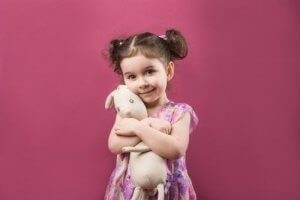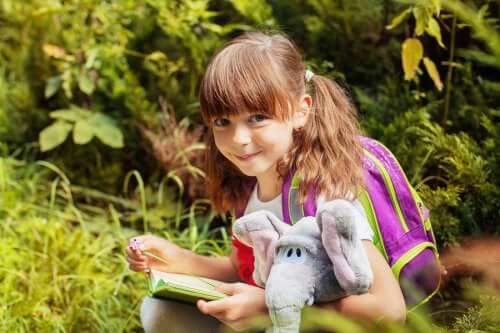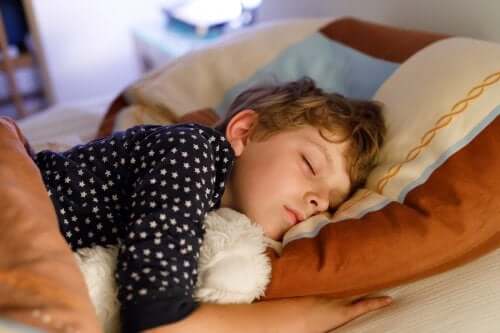Transitional Objects: The Toy Your Child Can't Live Without

We’ve all witnessed how children often have a special attachment or love for a certain stuffed animal or blanket. They take these objects with them wherever they go, and they can’t seem to live without them. But what do these transitional objects really represent on a psychological level?
What are transitional objects?
Pediatrician and psychoanalyst Donald Winnicott coined this term in reference to the first possession that a child recognizes as something separate from him or herself.
Transitional objects are material objects to which children feel a certain sense of attachment. They show special affection for this specific object, always carrying it close. They also tend to turn to this object especially in times where they’re upset or tired.
The position of children in regards to transitional objects is not a playful one, but rather one of possession. They hold them, suck on them, kiss them and press them against their bodies or even throw them on the floor.
Having a transitional object is a completely normal behavior within a child’s healthy psychological development. These objects fulfill an important function in the process of separation between children and their mothers. They also play an important role in a child’s self-identification as an individual.

However, given that this process is different in each person, not all children develop a relationship with a transitional object.
What are the characteristics of a transitional object?
There is a great deal of variety when it comes to transitional objects, and they’re different for each child. That being said, however, all transitional objects have some basic characteristics in common.
- They have a pleasant texture; they’re usually smooth and soft. This is directly related to the cloth mother figure in Harry Harlow’s attachment studies. According to his findings, all young creatures have an innate need for attachment to a soft figure in order to find refuge and protection.
- Children choose their transitional object randomly. Parents and caretakers cannot impose an attachment object. Rather, children must choose their own transitional objects, even if we as adults have other preferences.
- Transitional objects are irreplaceable. Just as it’s impossible for adults to impose transitional objects on their children, it’s also impossible to substitute them. If a transitional object ends up lost, the child will experience extreme sadness. This sadness won’t go away if parents try to replace the item with something else. It will be completely up to the child if he or she forms an attachment to another object.
- Transitional objects have a particular smell. This olfactory fingerprint helps children experience a sense of familiarity. For this reason, it’s best not to wash the object.
- They’re inseparable. Little ones carry their transitional objects everywhere they go, especially when it’s time to go to bed. It’s important not to take them away, as this produces a deep feeling of sadness and distress. Over time and as children develop, these objects will gradually lose their relevance.
What role do transitional objects play?
First of all, these objects represent a major transition in the development of children. As infants, children experience a total differentiation in regards to their mothers. In other words, they don’t perceive that their mothers are separate beings.
As they grow, they begin to understand this separation and comprehend that they’re two independent beings. Furthermore, they come to understand that their mothers can’t always tend to their needs 100% of the time.
Transitional objects accompany children as they go through this change and offer them some of the security that their moms provide. They represent the attachment that a baby feels for his or her mother, and carry out certain functions when she’s absent.
So then, transitional objects are a source of pleasure and security. They help little ones control their separation anxiety, to become emotionally independent, and to face situations.

When are transitional objects important?
These important psychological functions become clear especially in moments of distress, weariness, and at bedtime. In these instances, children show an even greater need to be close to their attachment objects.
Children may also resort back to their transitional objects – even if they’ve already abandoned them – during important events. For example, the birth of a new sibling, the start of school, moving to a new home, etc.
Children usually take on a transitional object between 4 and 6 months of age. This relationship usually lasts until the age of three and four, approximately.
Once children manage to gain control over their emotions and become more independent, the relationship with the object will become more playful. Or, they may naturally substitute the object with other interests.
We’ve all witnessed how children often have a special attachment or love for a certain stuffed animal or blanket. They take these objects with them wherever they go, and they can’t seem to live without them. But what do these transitional objects really represent on a psychological level?
What are transitional objects?
Pediatrician and psychoanalyst Donald Winnicott coined this term in reference to the first possession that a child recognizes as something separate from him or herself.
Transitional objects are material objects to which children feel a certain sense of attachment. They show special affection for this specific object, always carrying it close. They also tend to turn to this object especially in times where they’re upset or tired.
The position of children in regards to transitional objects is not a playful one, but rather one of possession. They hold them, suck on them, kiss them and press them against their bodies or even throw them on the floor.
Having a transitional object is a completely normal behavior within a child’s healthy psychological development. These objects fulfill an important function in the process of separation between children and their mothers. They also play an important role in a child’s self-identification as an individual.

However, given that this process is different in each person, not all children develop a relationship with a transitional object.
What are the characteristics of a transitional object?
There is a great deal of variety when it comes to transitional objects, and they’re different for each child. That being said, however, all transitional objects have some basic characteristics in common.
- They have a pleasant texture; they’re usually smooth and soft. This is directly related to the cloth mother figure in Harry Harlow’s attachment studies. According to his findings, all young creatures have an innate need for attachment to a soft figure in order to find refuge and protection.
- Children choose their transitional object randomly. Parents and caretakers cannot impose an attachment object. Rather, children must choose their own transitional objects, even if we as adults have other preferences.
- Transitional objects are irreplaceable. Just as it’s impossible for adults to impose transitional objects on their children, it’s also impossible to substitute them. If a transitional object ends up lost, the child will experience extreme sadness. This sadness won’t go away if parents try to replace the item with something else. It will be completely up to the child if he or she forms an attachment to another object.
- Transitional objects have a particular smell. This olfactory fingerprint helps children experience a sense of familiarity. For this reason, it’s best not to wash the object.
- They’re inseparable. Little ones carry their transitional objects everywhere they go, especially when it’s time to go to bed. It’s important not to take them away, as this produces a deep feeling of sadness and distress. Over time and as children develop, these objects will gradually lose their relevance.
What role do transitional objects play?
First of all, these objects represent a major transition in the development of children. As infants, children experience a total differentiation in regards to their mothers. In other words, they don’t perceive that their mothers are separate beings.
As they grow, they begin to understand this separation and comprehend that they’re two independent beings. Furthermore, they come to understand that their mothers can’t always tend to their needs 100% of the time.
Transitional objects accompany children as they go through this change and offer them some of the security that their moms provide. They represent the attachment that a baby feels for his or her mother, and carry out certain functions when she’s absent.
So then, transitional objects are a source of pleasure and security. They help little ones control their separation anxiety, to become emotionally independent, and to face situations.

When are transitional objects important?
These important psychological functions become clear especially in moments of distress, weariness, and at bedtime. In these instances, children show an even greater need to be close to their attachment objects.
Children may also resort back to their transitional objects – even if they’ve already abandoned them – during important events. For example, the birth of a new sibling, the start of school, moving to a new home, etc.
Children usually take on a transitional object between 4 and 6 months of age. This relationship usually lasts until the age of three and four, approximately.
Once children manage to gain control over their emotions and become more independent, the relationship with the object will become more playful. Or, they may naturally substitute the object with other interests.
All cited sources were thoroughly reviewed by our team to ensure their quality, reliability, currency, and validity. The bibliography of this article was considered reliable and of academic or scientific accuracy.
- Harlow, H. F. (1962). Development of affection in primates. Roots of behavior: genetics, instinct, and socialization in animal behavior/by thirty-one authors; edited by Eugene L. Bliss.
- Winnicott, D. W. (1967). Objetos y fenómenos transicionales : Un estudio sobre la primera posesión no Yo. Recuperado de https://www.pep-web.org/document.php?id=revapa.024.0817a
This text is provided for informational purposes only and does not replace consultation with a professional. If in doubt, consult your specialist.








